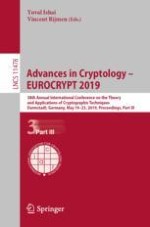2019 | OriginalPaper | Chapter
Group Signatures Without NIZK: From Lattices in the Standard Model
Authors : Shuichi Katsumata, Shota Yamada
Published in: Advances in Cryptology – EUROCRYPT 2019
Publisher: Springer International Publishing
Activate our intelligent search to find suitable subject content or patents.
Select sections of text to find matching patents with Artificial Intelligence. powered by
Select sections of text to find additional relevant content using AI-assisted search. powered by
Abstract
-
Our first construction is proven secure assuming the standard LWE and the SIS assumption. The sizes of the public parameters and the signatures grow linearly in the number of users in the system.
-
Our second construction is proven secure assuming the standard LWE and the subexponential hardness of the SIS problem. The sizes of the public parameters and the signatures are independent of the number of users in the system.
